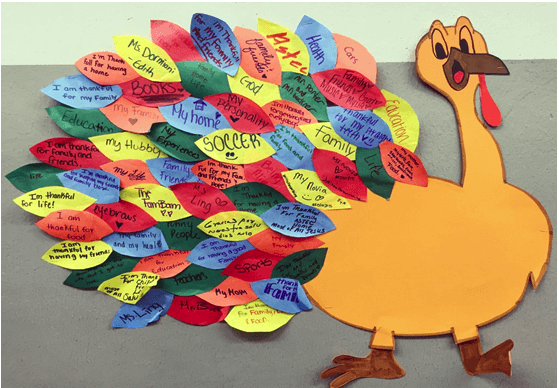8.17: Attitude of Gratitude
- Page ID
- 14107
\( \newcommand{\vecs}[1]{\overset { \scriptstyle \rightharpoonup} {\mathbf{#1}} } \)
\( \newcommand{\vecd}[1]{\overset{-\!-\!\rightharpoonup}{\vphantom{a}\smash {#1}}} \)
\( \newcommand{\id}{\mathrm{id}}\) \( \newcommand{\Span}{\mathrm{span}}\)
( \newcommand{\kernel}{\mathrm{null}\,}\) \( \newcommand{\range}{\mathrm{range}\,}\)
\( \newcommand{\RealPart}{\mathrm{Re}}\) \( \newcommand{\ImaginaryPart}{\mathrm{Im}}\)
\( \newcommand{\Argument}{\mathrm{Arg}}\) \( \newcommand{\norm}[1]{\| #1 \|}\)
\( \newcommand{\inner}[2]{\langle #1, #2 \rangle}\)
\( \newcommand{\Span}{\mathrm{span}}\)
\( \newcommand{\id}{\mathrm{id}}\)
\( \newcommand{\Span}{\mathrm{span}}\)
\( \newcommand{\kernel}{\mathrm{null}\,}\)
\( \newcommand{\range}{\mathrm{range}\,}\)
\( \newcommand{\RealPart}{\mathrm{Re}}\)
\( \newcommand{\ImaginaryPart}{\mathrm{Im}}\)
\( \newcommand{\Argument}{\mathrm{Arg}}\)
\( \newcommand{\norm}[1]{\| #1 \|}\)
\( \newcommand{\inner}[2]{\langle #1, #2 \rangle}\)
\( \newcommand{\Span}{\mathrm{span}}\) \( \newcommand{\AA}{\unicode[.8,0]{x212B}}\)
\( \newcommand{\vectorA}[1]{\vec{#1}} % arrow\)
\( \newcommand{\vectorAt}[1]{\vec{\text{#1}}} % arrow\)
\( \newcommand{\vectorB}[1]{\overset { \scriptstyle \rightharpoonup} {\mathbf{#1}} } \)
\( \newcommand{\vectorC}[1]{\textbf{#1}} \)
\( \newcommand{\vectorD}[1]{\overrightarrow{#1}} \)
\( \newcommand{\vectorDt}[1]{\overrightarrow{\text{#1}}} \)
\( \newcommand{\vectE}[1]{\overset{-\!-\!\rightharpoonup}{\vphantom{a}\smash{\mathbf {#1}}}} \)
\( \newcommand{\vecs}[1]{\overset { \scriptstyle \rightharpoonup} {\mathbf{#1}} } \)
\( \newcommand{\vecd}[1]{\overset{-\!-\!\rightharpoonup}{\vphantom{a}\smash {#1}}} \)
\(\newcommand{\avec}{\mathbf a}\) \(\newcommand{\bvec}{\mathbf b}\) \(\newcommand{\cvec}{\mathbf c}\) \(\newcommand{\dvec}{\mathbf d}\) \(\newcommand{\dtil}{\widetilde{\mathbf d}}\) \(\newcommand{\evec}{\mathbf e}\) \(\newcommand{\fvec}{\mathbf f}\) \(\newcommand{\nvec}{\mathbf n}\) \(\newcommand{\pvec}{\mathbf p}\) \(\newcommand{\qvec}{\mathbf q}\) \(\newcommand{\svec}{\mathbf s}\) \(\newcommand{\tvec}{\mathbf t}\) \(\newcommand{\uvec}{\mathbf u}\) \(\newcommand{\vvec}{\mathbf v}\) \(\newcommand{\wvec}{\mathbf w}\) \(\newcommand{\xvec}{\mathbf x}\) \(\newcommand{\yvec}{\mathbf y}\) \(\newcommand{\zvec}{\mathbf z}\) \(\newcommand{\rvec}{\mathbf r}\) \(\newcommand{\mvec}{\mathbf m}\) \(\newcommand{\zerovec}{\mathbf 0}\) \(\newcommand{\onevec}{\mathbf 1}\) \(\newcommand{\real}{\mathbb R}\) \(\newcommand{\twovec}[2]{\left[\begin{array}{r}#1 \\ #2 \end{array}\right]}\) \(\newcommand{\ctwovec}[2]{\left[\begin{array}{c}#1 \\ #2 \end{array}\right]}\) \(\newcommand{\threevec}[3]{\left[\begin{array}{r}#1 \\ #2 \\ #3 \end{array}\right]}\) \(\newcommand{\cthreevec}[3]{\left[\begin{array}{c}#1 \\ #2 \\ #3 \end{array}\right]}\) \(\newcommand{\fourvec}[4]{\left[\begin{array}{r}#1 \\ #2 \\ #3 \\ #4 \end{array}\right]}\) \(\newcommand{\cfourvec}[4]{\left[\begin{array}{c}#1 \\ #2 \\ #3 \\ #4 \end{array}\right]}\) \(\newcommand{\fivevec}[5]{\left[\begin{array}{r}#1 \\ #2 \\ #3 \\ #4 \\ #5 \\ \end{array}\right]}\) \(\newcommand{\cfivevec}[5]{\left[\begin{array}{c}#1 \\ #2 \\ #3 \\ #4 \\ #5 \\ \end{array}\right]}\) \(\newcommand{\mattwo}[4]{\left[\begin{array}{rr}#1 \amp #2 \\ #3 \amp #4 \\ \end{array}\right]}\) \(\newcommand{\laspan}[1]{\text{Span}\{#1\}}\) \(\newcommand{\bcal}{\cal B}\) \(\newcommand{\ccal}{\cal C}\) \(\newcommand{\scal}{\cal S}\) \(\newcommand{\wcal}{\cal W}\) \(\newcommand{\ecal}{\cal E}\) \(\newcommand{\coords}[2]{\left\{#1\right\}_{#2}}\) \(\newcommand{\gray}[1]{\color{gray}{#1}}\) \(\newcommand{\lgray}[1]{\color{lightgray}{#1}}\) \(\newcommand{\rank}{\operatorname{rank}}\) \(\newcommand{\row}{\text{Row}}\) \(\newcommand{\col}{\text{Col}}\) \(\renewcommand{\row}{\text{Row}}\) \(\newcommand{\nul}{\text{Nul}}\) \(\newcommand{\var}{\text{Var}}\) \(\newcommand{\corr}{\text{corr}}\) \(\newcommand{\len}[1]{\left|#1\right|}\) \(\newcommand{\bbar}{\overline{\bvec}}\) \(\newcommand{\bhat}{\widehat{\bvec}}\) \(\newcommand{\bperp}{\bvec^\perp}\) \(\newcommand{\xhat}{\widehat{\xvec}}\) \(\newcommand{\vhat}{\widehat{\vvec}}\) \(\newcommand{\uhat}{\widehat{\uvec}}\) \(\newcommand{\what}{\widehat{\wvec}}\) \(\newcommand{\Sighat}{\widehat{\Sigma}}\) \(\newcommand{\lt}{<}\) \(\newcommand{\gt}{>}\) \(\newcommand{\amp}{&}\) \(\definecolor{fillinmathshade}{gray}{0.9}\)Learn:
- About the power of gratitude and how to incorporate gratitude practices into their everyday lives.
Giveaway: Chocolate/ Dark Chocolate/ Almonds
Tools:
- Signage and hangouts (e.g. ways to express gratitude)
- Turkey cut out (big turkey)
- Blank paper leaves (different colors of paper)
- Markers/ Tape
- Thank You Cards/ Bowl
- Chocolate/ Dark Chocolate Almonds
- Feedback survey, pencils and collection box
Set-Up:
- Cut out paper leaves and a turkey
- Draw a "naked" turkey on a large sheet of butcher paper
- Display signage to highlight the goal of your demo
- Place thank you cards on the table
Activity:
- Invite participants to write something they are thankful on a turkey feather and post it to the turkey.
- Have participants write a thank you card to a teacher. Collect them, filter through and distribute among the teachers.
- Have chocolate, dark chocolate, or almonds as a gift for participating.
- Ask participants to complete feedback survey.
Talking Points:
- Introduction: what are you thankful for this year?
- Would you like to write what you're thankful for?
- Do you know what gratitude means?
- Gratitude helps people refocus on what they have instead of what they lack. And although it may feel unnatural at first, this mental state grows stronger with use and practice.
Suggested Information for Café O Yea:
Key Terms:
- Grateful: Warmly or deeply appreciative or kindness or benefits received.
- Gratitude: A feeling of appreciation and thanks.
Facts:
- Gratitude is strongly and consistently associated with grater happiness.
- Gratitude helps people feel more positive emotions, appreciate good experiences, improve their health, deal with adversity, and build strong relationships.
- Gratitude is a way for people to appreciate what they have instead of always reaching for something new in the hopes it will make them happier, or thinking they can't feel satisfied until every physical and material need is met.
Ways to Show Gratitude:
- write a thank-you note: You can make yourself happier and nurture your relationship with another person by writing a thank-you letter expressing your enjoyment and appreciation of that person's impact on your life. Send it, or better yet, deliver and read it in person if possible. Make a habit of sending at least one gratitude letter a month. Once in a while, write one to yourself.
- Thank someone mentally: No time to write? It may help just to think about someone who has done something nice for you, and mentally thank the individual.

- Keep a gratitude journal: Make it a habit to write down or share with loved one thoughts about the gifts you've received each day.

- Count your blessings: Pick a time every week to sit down and write about your blessings, reflecting on what went right or what you are grateful for. Sometimes it helps to pick a number, such as three to five things, that you will identify each week. As you write, be specific and think about the sensations you felt when something good happened to you.

- Pray: People who are religious can use prayer to cultivate gratitude.

- Meditate: Mindfulness meditation involves focusing on the present moment without judgment. Although people often focus on a word or phrase (such as "peace"), it is also possible to focus on what you're grateful for.

Resources:
- Merriam Webster. "Definition of Grateful". Retrieved from: http://www.dictionary.com/browse/grateful
- Merriam Webster. "Definition of Gratitude". Retrieved from: http://www.learnersdictionary.com/de...tion/gratitude
- Emmons RA, et al. "Counting Blessings Versus Burdens: An experimental Investigation of Gratitude and Subjective Well-Being in Daily Life," Journal of Personality and Social Psychology (Feb, 2003): Vol. 84, No. 2, pp. 377-89.
- Grant AM, et al. "A Little Thanks Goes a Long Way: Explaining Why Gratitude Expressions Motivate Prosocial Behavior," Journal of Personality and Social Psychology (June 2010): Vol. 98, No. 6, pp. 946-55.
- Harvard Medical Publications. "In Praise of Gratitude." Retrieved from: www.health.harvard.edu/newsle...e-of-gratitude
- Lambert NM, et al. "Expressing Gratitude to a Partner Lead to More Relationship Maintenance Behavior," Emotion (Feb. 2011): Vol. 11, No. 1, pp. 52-60.
- Sansone RA, et al. "Gratitude and Well Being: The Benefits of Appreciation," Psychiatry (Nov. 2010): Vol. 7, No. 11, pp. 18-22.
- Seligman MEP, et al. "Empirical Validation of Interventions," American Psychologist (July-Aug. 2005): Vol. 60, No. 1, pp. 410-21.

